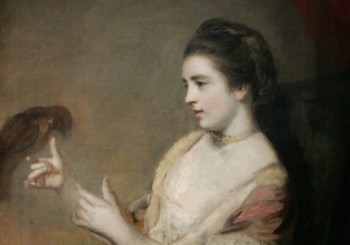IMAGINE – this might be a little tricky – that you are a young woman living in Scotland in the 16th century. What would you know about sex? Well, you would know that your sexual life was policed and scrutinized: by family, by neighbors, by the law, by the church.

Sex before marriage (even with the promise of marriage to come) could be punished by public repentance, having your hair shorn off, and being attached with a “joug” – an iron collar – to the merkat cross.
If you did succumb to temptation, it would be in the knowledge that women were, by nature, the lustier of the sexes and less capable of suppressing those urges. Were you literate, you might even have read about Chaucer’s Wife of Bath, or Dunbar’s The Twa Merrit Wemen And The Wedo, which amply proved the point. Above all, you would have no sense whatsoever that your sexuality was a private affair. The very concept of a “private life” barely existed. Although Philip Larkin claimed that “sexual intercourse began in 1963 … between the end of the Chatterley Ban and the Beatles’ first LP”, a new book by Oxford academic Faramerz Dabhoiwala is less specific and more detailed.
To compare contemporary sexual mores and attitudes with the mindset of the hypothetical Scottish lass of the days of the Reformation is to witness an absolute transformation in ideas about sex. It is now men who are deemed to have unbridled appetites. The law, for the most part, does not concern itself with sex between consenting adults. The role of the Church in punishing sexual misdemeanor has evaporated and the idea that it is the function of either government or Church to impose morality by force is gone. In the mostly liberal West, we tend to see theocratic meddling in private matters as a sign of backwardness. Between 1600 and 1800, almost every commonly-held belief about sex was challenged, and we live with the fractious consequences of those changes.
How did such a reversal come about? There is no one answer, but a series of interconnected developments all of which contributed to changes in our approach towards sex, and which were themselves changed by new kinds of thinking about sex. The first, and most obvious, difference was urbanization. The anonymous new spaces of the city created opportunities that could not be countenanced in close-knit rural communities. The second, less evident, factor was that the “first sexual revolution” happened at the same time as massive political and religious revolutions in Britain.
Central to these changes was the thinking of the philosopher John Locke. A number of Locke’s ideas proved crucial in altering views about sexuality, although surprisingly, none of them addressed it directly. In his A Letter Concerning Toleration, Locke argued that our spiritual beliefs cannot be changed by force, and that since they are essentially private, they do not threaten social stability. In his Essay Concerning Human Understanding, he developed the idea that a human is a tabula rasa – a blank slate – at birth. If we do not arrive in this world with preconceived ideas about justice or bravery, nor do we arrive with original sin. And if toleration can be extended to ideas about bishops, why should it not be extended to ideas about adultery? Locke himself, alert to this potential slippage, repeatedly, and to little avail, tried to say that toleration did not encompass “licentious” matters. A remarkable suicide note in the book, written by a woman known only as “H. B.”, says of her seducer, “Mr L should not read Mr Locke’s books so much”.
The changing nature of Biblical interpretation also let the cat out of the metaphorical bag. If we no longer stoned adulterers, maybe we needn’t punish adultery at all? If we did stick to the letter of the text, would it be possible to stick to polygamy and concubines as well? These issues, as the debate about same-sex marriage rumbles on, are still with us.
Attitudes to sex were always also attitudes towards class. The newly emerging bourgeoisie was trapped between a working class characterized as insatiable and immoral and an aristocracy that made no attempt to hide its mistresses and peccadilloes. It was this audience that thrilled to novels such as Samuel Richardson’s Pamela, where the virtuous maidservant fends off the advances of her employer until her goodness transforms him and he offers marriage instead.
On the stage, more and more plays – Rowe’s The Fair Penitent, Otway’s The Orphan, even Tate’s libretto for Purcell’s Dido and Aeneas – depicted inherently good women undone by faithless men. This set up a feedback loop into reality. Prostitutes began to be seen as victims first and foremost, not inherently wicked nymphomaniacs – and more and more charitable foundations were created to “save” fallen women. Pretty Woman is the direct descendant of the “tart with the heart” narratives we find in this period.
The availability of reliable contraception is sometimes seen as the beginning of the second “sexual revolution”. But the history as sketched by Dabhoiwala shows that there is rarely a single event or root cause for such things, and that they evolve over long periods of time. There are, however, clear signs that things are changing, or perhaps changing back.
There is no longer a fornicator’s stool in the local Kirk, but adulterers and the unfaithful are still regularly paraded for public mockery on The Jeremy Kyle Show. Under parish poor laws, illegitimate children were seen as a drain on scant resources and their parents characterized as deliberately “indolent”. It’s hard not to see a modern parallel in the tabloid outrage at single mothers with supposedly exorbitant benefit cheques. Nobody nowadays believes that to rape a prostitute is not a crime (as Jeremy Bentham thought: they had no virtue to lose); but prurient detailing of victims’ lives is still a staple part of cross-examination.
How private are our private lives? It seems an ironic consequence of the invention of sexual privacy that we now live in a society awash with sexual imagery. “Our” private lives are meant to be private, but those of people in public office, or the public eye, are definitely not. Whether you are Britney Spears or Chris Huhne, your sexual behaviour is thought to be a matter of public concern, and moral judgements will be passed on it. The intersection of sex and celebrity is nothing new – even when the celebrity is only famous for sex. Katie Price’s formidable publishing enterprise has its precedents in the 18th century memoirs of celebrated courtesans such as Kitty Fisher and Sally Salisbury.
If there is a message to be taken from Dabhoiwala’s study it is that things other than debates about sex change attitudes towards sex. In contemporary terms, we can see that communication technologies provide the same kind of anonymous spaces that sprawling metropolises once did; and that the same forms of sexual exploitation can occur in them.
A history of sex is often a history of people earning the right to say yes – to sex with someone other that your parents’ choice of husband or wife, to sex with someone before getting married, to sex with someone of the same sex. At the same time there is a counter-history of the right to say no, one that our hyper-sexualised culture might struggle to hear as clearly.
• The Origins of Sex: The History of the First Sexual Revolution by Faramerz Dabhoiwala, Allen Lane, 496pp,
Source
Scotsman.com





